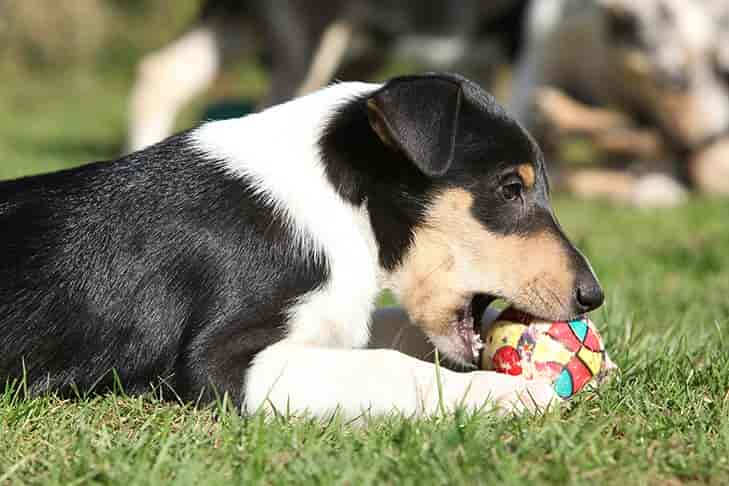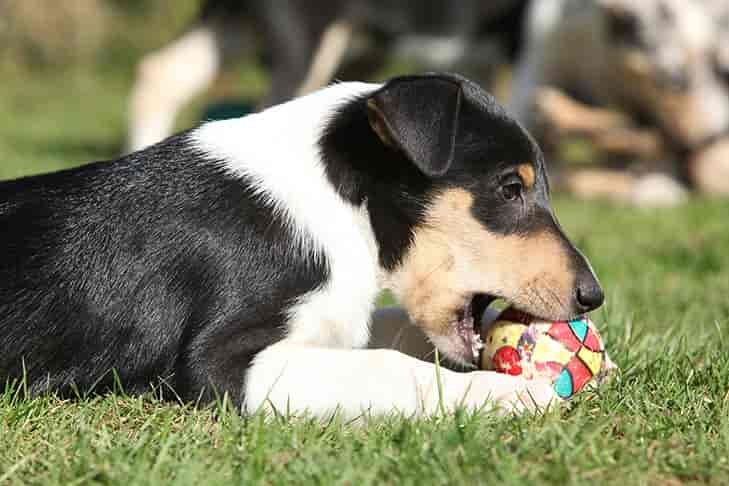Aggression is one of the most common reasons pet owners seek professional help for their dogs. But what is aggression? Aggression is hostile, injurious, or destructive behavior toward an individual, whether human or another animal.
It’s important to determine the cause of aggression to deal appropriately with the issue at hand. Aggression in dogs can be due to guarding territory, resources, or a family member; fear; frustration; prey drive; or pain. In all of these situations, a dog may be pushed too far and can transition quickly from reactive, fearful, or guarding behaviors to being aggressive.
Behaviors That Sometimes Lead to Aggression
Reactivity: Reactivity is commonly confused with aggression. Dogs that are reactive overreact to certain stimuli or situations. Genetics, lack of socialization, insufficient training to learn self-control, a frightening experience, or a combination of these can cause reactivity, and fear is typically the driving force.
Reactive dogs have certain triggers, such as men with beards or hats, small children, or situations when the dog feels trapped on a leash. If a reactive dog approaches you, the best thing you can do is give him space. Do not approach in an attempt to greet him. If you have a reactive dog, working with a trainer to try behavior modification techniques that will address the cause can prevent escalation to aggression.
Fight or Flight: Fear is the most common cause of aggression. Normally when a dog is scared and feels threatened, he chooses to run from whatever is frightening him. In situations where a dog is trapped or cornered and can’t flee, he may fight to protect himself. Fearful dogs may not give any warnings other than their body language. Bites are typically quick snaps and may occur when the person is leaving and has his back turned.
There would be fewer bites if people understood that our behavior, even when we think it is friendly, could appear threatening to a dog. For example, when we lean over a dog and reach out a hand to pet him on top of his head, he may feel threatened. Another common cause of fearfulness in dogs is lack of socialization. A dog who has positive experiences with different types of people, noises, and places from a young age is less likely to be fearful. Teaching a puppy to relax when being handled will also help.
Resource Guarding – Dogs tend to guard things they believe hold great worth. These items can be toys, food, bones, sleeping areas, and even people. This tendency comes from the fact that dogs descended from ancestors that were wild and had to protect their resources to survive.
Teaching dogs behaviors such as “leave it,” “out,” and “place” or “off” can help curb this behavior. Another good way to deal with resource guarding is to trade with your dog, exchanging the object that he is guarding for a treat, or stand away from the food bowl when the dog is eating and toss a treat into it.
Leash Reactivity – Leash-reactive dogs tend to growl, bark, and/or lunge toward things that make them nervous or fearful. These triggers may be other dogs or people and can be specific, such as children, men, people wearing hats, or male/female dogs. Dogs that display these behaviors are trying to prevent a fight by making the threat go away or by increasing the distance between themselves and the threat.
Behaviors That Look Like Aggression
Listed below are some of the behaviors commonly confused with aggression:
Mouthing/Nipping Puppies – Puppies interact with their world through their mouth. When puppies play, with other dogs or their owners, they can become mouthy and nip harder than they should. This nipping is not coming from a puppy that is being aggressive, but one who is over-stimulated and needs a break.
Rough Play – Dog-to-dog play is a normal part of canine interaction. Dog play is mock fighting. Puppies learn how to do this appropriately from their peers. Dog play can become intense, get loud, and appear aggressive, but as long as both dogs are having fun and respecting their body language, it can be a great activity for socialization and exercise.
Physical Discomfort — A dog who is suddenly growling or snapping may also be sick or in pain. “If the behavior is atypical and comes on unexpectedly, you may want to take your dog to your veterinarian for an exam to determine if there’s a medical cause,” says Dr. Jerry Klein, AKC chief veterinary officer.
Body Language
Since dogs can’t talk, they rely on their body language to tell other dogs and humans how they are feeling about different situations. Below are common body language signals that everyone who interacts with dogs should understand.
Signs of a friendly dog:
- Relaxed body
- Happy expression, soft mouth
- Wagging tail
- Play bow
- Ears relaxed
- Relaxed tail or wag that wiggles whole body
- Rolling over, belly up
- Leaning in for petting
- Soft eyes, gentle gaze, blinks often
Signs of anxiety:
- Yawning when not tired
- Lip licking
- Sudden scratching
- Sniffing
- Panting
- Tail tucked under body
Signs of arousal:
- Ears forward, mouth closed
- Eyes intense, showing more white
- Body forward, tense
- Tail high, slowly wagging
- Hackles raised
Signs prior to a bite:
- Signs of anxiety or arousal
- Intense eye contact
- Showing whites of eyes
- Growling
- Showing teeth
- Tense body
If you believe your dog is aggressive, it’s best to seek professional help. You can ask your veterinarian for a reference for a certified animal behaviorist in your area. Other resources are the International Association of Animal Behavior Consultants, the Certification Council for Professional Dog Trainers, and the Association of Professional Dog Trainers. In the meantime, you’ll need to carefully avoid putting your dog in situations that may lead to aggressive behavior.
Aggression is one of the most common reasons pet owners seek professional help for their dogs. But what is aggression? Aggression is hostile, injurious, or destructive behavior toward an individual, whether human or another animal.
It’s important to determine the cause of aggression to deal appropriately with the issue at hand. Aggression in dogs can be due to guarding territory, resources, or a family member; fear; frustration; prey drive; or pain. In all of these situations, a dog may be pushed too far and can transition quickly from reactive, fearful, or guarding behaviors to being aggressive.
Behaviors That Sometimes Lead to Aggression
Reactivity: Reactivity is commonly confused with aggression. Dogs that are reactive overreact to certain stimuli or situations. Genetics, lack of socialization, insufficient training to learn self-control, a frightening experience, or a combination of these can cause reactivity, and fear is typically the driving force.
Reactive dogs have certain triggers, such as men with beards or hats, small children, or situations when the dog feels trapped on a leash. If a reactive dog approaches you, the best thing you can do is give him space. Do not approach in an attempt to greet him. If you have a reactive dog, working with a trainer to try behavior modification techniques that will address the cause can prevent escalation to aggression.
Fight or Flight: Fear is the most common cause of aggression. Normally when a dog is scared and feels threatened, he chooses to run from whatever is frightening him. In situations where a dog is trapped or cornered and can’t flee, he may fight to protect himself. Fearful dogs may not give any warnings other than their body language. Bites are typically quick snaps and may occur when the person is leaving and has his back turned.
There would be fewer bites if people understood that our behavior, even when we think it is friendly, could appear threatening to a dog. For example, when we lean over a dog and reach out a hand to pet him on top of his head, he may feel threatened. Another common cause of fearfulness in dogs is lack of socialization. A dog who has positive experiences with different types of people, noises, and places from a young age is less likely to be fearful. Teaching a puppy to relax when being handled will also help.
Resource Guarding – Dogs tend to guard things they believe hold great worth. These items can be toys, food, bones, sleeping areas, and even people. This tendency comes from the fact that dogs descended from ancestors that were wild and had to protect their resources to survive.
Teaching dogs behaviors such as “leave it,” “out,” and “place” or “off” can help curb this behavior. Another good way to deal with resource guarding is to trade with your dog, exchanging the object that he is guarding for a treat, or stand away from the food bowl when the dog is eating and toss a treat into it.
Leash Reactivity – Leash-reactive dogs tend to growl, bark, and/or lunge toward things that make them nervous or fearful. These triggers may be other dogs or people and can be specific, such as children, men, people wearing hats, or male/female dogs. Dogs that display these behaviors are trying to prevent a fight by making the threat go away or by increasing the distance between themselves and the threat.
Behaviors That Look Like Aggression
Listed below are some of the behaviors commonly confused with aggression:
Mouthing/Nipping Puppies – Puppies interact with their world through their mouth. When puppies play, with other dogs or their owners, they can become mouthy and nip harder than they should. This nipping is not coming from a puppy that is being aggressive, but one who is over-stimulated and needs a break.
Rough Play – Dog-to-dog play is a normal part of canine interaction. Dog play is mock fighting. Puppies learn how to do this appropriately from their peers. Dog play can become intense, get loud, and appear aggressive, but as long as both dogs are having fun and respecting their body language, it can be a great activity for socialization and exercise.
Physical Discomfort — A dog who is suddenly growling or snapping may also be sick or in pain. “If the behavior is atypical and comes on unexpectedly, you may want to take your dog to your veterinarian for an exam to determine if there’s a medical cause,” says Dr. Jerry Klein, AKC chief veterinary officer.
Body Language
Since dogs can’t talk, they rely on their body language to tell other dogs and humans how they are feeling about different situations. Below are common body language signals that everyone who interacts with dogs should understand.
Signs of a friendly dog:
- Relaxed body
- Happy expression, soft mouth
- Wagging tail
- Play bow
- Ears relaxed
- Relaxed tail or wag that wiggles whole body
- Rolling over, belly up
- Leaning in for petting
- Soft eyes, gentle gaze, blinks often
Signs of anxiety:
- Yawning when not tired
- Lip licking
- Sudden scratching
- Sniffing
- Panting
- Tail tucked under body
Signs of arousal:
- Ears forward, mouth closed
- Eyes intense, showing more white
- Body forward, tense
- Tail high, slowly wagging
- Hackles raised
Signs prior to a bite:
- Signs of anxiety or arousal
- Intense eye contact
- Showing whites of eyes
- Growling
- Showing teeth
- Tense body
If you believe your dog is aggressive, it’s best to seek professional help. You can ask your veterinarian for a reference for a certified animal behaviorist in your area. Other resources are the International Association of Animal Behavior Consultants, the Certification Council for Professional Dog Trainers, and the Association of Professional Dog Trainers. In the meantime, you’ll need to carefully avoid putting your dog in situations that may lead to aggressive behavior.




